This tour explores some of the towns and countryside lying within easy reach of Ancona, the regional capital of the Marche. This bustling city is the main gateway to the area both by plane and ferry, giving the place the atmosphere of a Mediterranean frontier. The influence of the East is also evident in some of its earliest architectural attractions - don’t miss the Cathedral of San Ciriaco, on the hill above the port - parts of the Byzantine mosaic floor of the original 6th century church can still be seen.
Our route avoids the busy city arteries and leaves by the backdoor along quieter and prettier roads to explore the seaside scenery of Monte Conero, some of the finest coastline in the whole of the Marche region.
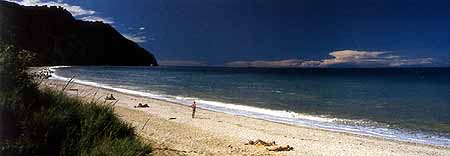
The seaside scenery of Monte Conero
It then heads for a short distance inland to visit five splendid hill towns, each with its own particular fascination. From the tomb of St Joseph of Copertino in Osimo, we travel to Castelfidardo, the capital of the accordion, and on to the Marche’s most important place of pilgrimage, the Sanctuary of the Holy House at Loreto before arriving at the patrician town of Recanati, home of one of Italy’s greatest Romantic poets, Giacomo Leopardi, as well as the great operatic tenor, Beniamino Gigli.
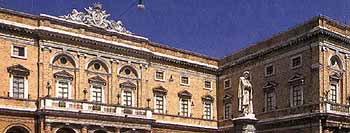
Recanati
The next leg of the tour takes us to one of the finest surviving 18th century gardens in Italy before heading across to the provincial capital of Macerata. The attraction of the final stage of the tour is the scenery, with some extra bonuses, including a Roman amphitheatre and a string of beautiful small hill towns which still remain well off the tourist track.
The Route
Part I - Ancona to Loreto
From the port, head eastwards through the city to the coast road, and pick up the signs for Monte Conero. The road soon begins to rise and within a short while leaves the city suburbs to arrive at the slopes of Monte Conero. After a few more kilometres the mountain’s solitary limestone peak comes into view. At 572 metres, this is the highest point along this stretch of the Adriatic coast and offers some spectacular views.
A short detour takes you down to the beach resort of Portonovo and the early Romanesque church of Santa Maria. Built between 1034 and 1048, its curious form is unique in Italy and looks as if it might be more at home in Normandy.
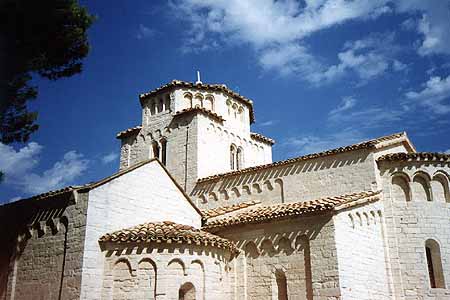
S. Maria di Portonovo
Back on the main road, after eight kilometres, another left turn takes you on a second detour up to the highest point on the mountain reachable by car, and worth the trip just for the views. Here you’ll find the Badia di San Pietro, built in the 12thC as a Benedictine Hermitage and now a hotel. The area is also a regional nature park and a web of signed footpaths cover the peak. On the summit, traces of a Palaeolithic settlement dating back 100,000 years have been discovered - the earliest signs of human presence in the region.
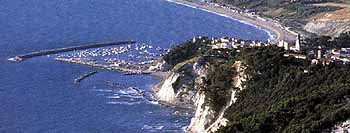
Sirolo
Returning to the main road, we now head down to the southern flanks of Conero to visit Sirolo. Its balcony piazza, flanked on two sides by a spruce medieval centre, teeters high above the sea, offering magnificent views. Its sister resort, Numana, lies further down the slope, at beach level. The port dates back as far as the 8th century BC - various bronzes and pieces of pottery found in the area can be seen in the Antiquarium in via La Fenice, in the centre of the old town. Both resorts have a wide range of hotels and campsites by the beach.
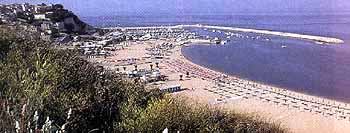
Numana
Leaving the coast behind we now travel inland to visit four important hill towns which lie only a few kilometres away - follow the signs for Osimo. Driving along the plain below the slopes of Monte Conero, the road passes vineyards producing Rosso Conero, one of the Marche’s fourteen DOC wines and perhaps its finest red. There are several cantine, or wineries, in the area where you can stop to buy a bottle or two, or simply to taste this rich, perfumed wine.
Our next destination is the homely town of Osimo which looms ahead of you on the crest of a hill. Enjoy the views out over classic Marche countryside as the road rises up towards the town. The town's compact, warm brick centro storico rides the crest of a hill above the more modern town expansion below. Most of its best buildings date from the 17th and 18thC but signs of its ancient past sometimes show through. Drop into the entrance hall of the Palazzo Comunale in main Piazza del Comune to see a dozen statues from Roman Auximum, as the place was called in ancient times, and hunt out the mighty blocks of the Roman walls above Via Fonte Magna. The street plan of the old town still retains its Roman layout. The mosaic pavement of the Duomo is a fine relic of Medieval times. The old Romanesque church of San Francesco has been smothered inside and out in High Baroque to celebrate its later reincarnation as the Sanctuary dedicated to San Giuseppe da Copertino (1603-1663). St Joseph of Copertino is known as the patron saint of those undergoing exams. Thanks also to his celebrated capacity for levitation he is also much invoked in the U.S.A as a protector of pilots.
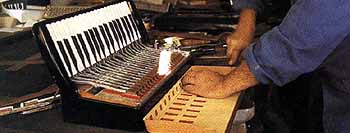
Strumenti musicali a Castelfidardo
Our next place on the route is Castelfidardo, about five kilometres away. The land below this statuesque small hill town was the scene of a celebrated battle in the fight for the Unification of Italy, when the Piedmont army routed the "crusaders" of the Papal forces in 1860. It now styles itself the world capital of the accordion, or fisarmonica. In its Museo Internazionale della Fisarmonica you can see more than 150 examples of the instrument. The town still has a thriving musical instrument industry and claims that the piano accordion was developed here in 1863 from the more primitive Austrian squeeze box. If you are here in October, come to the International Accordion Festival and discover that there are musicians who can transform the sound of this humble instrument into unimaginable artistry.
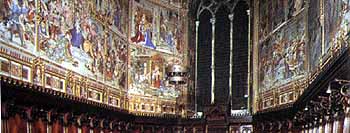
Coro Ligneo - Loreto
The high, gleaming dome on the hill announces that our next stop is no ordinary town. Loreto stands second only to Assisi and Rome as a place of pilgrimage and the striking hill town is one of the world's most important shrines to Our Lady. The great dome of the Sanctuario della Santa Casa dominates the countryside for miles around; below it stands the focus of worship - the Holy House, the rustic cottage from Nazareth that witnessed the Annunciation and the childhood of Jesus.
Although the Holy House arrived, according to tradition, in 1294, it was not until 1507 that the Catholic Church finally approved Loreto as a place of pilgrimage, though work on the church had begun in 1468. It was Pope Julius II who decided to pull out all the stops and give the simple cottage a fit setting. The result is a showcase of work by many of the most celebrated names of Late Renaissance Italy and gives even the unbeliever good reason to come here. Started on Gothic lines, later architects including Bramante and Sansovino gave the church a thorough Late Renaissance treatment. Piazza della Madonna, the elegant set-piece square with a delicate Baroque fountain that fronts the Sanctuary is flanked on two sides by the arcades of the 16thC Palazzo Apostolico. The Museo-Pinacoteca inside preserves a fine group of late works by Lorenzo Lotto (the Venetian master retired and died in the monastery here in 1556) and an unusual collection of Renaissance ceramic chemical jars.
Part II - Loreto to Macerata
A few kilometres on from Loreto, we reach Recanati. The quiet nobility of this attractive place warrants a relaxing pause on the journey. This was the birthplace of Giacomo Leopardi, one of Italy’s greatest Romantic poets and here you can stroll up to Piazza Leopardi, the town’s urbane central piazza, and spot the plaques quoting the poet’s praise for the buildings and monuments of his home town. The new museum in Villa Colloredo-Mels, a splendid 18th century villa on the edge of town, holds Recanati's greatest art treasure, a room with four of Lorenzo Lotto's finest pictures, including a most haunting Annunciation packed with almost breathless narrative detail - a high spot in any art-lover's tour of the central Marche.
Our journey now takes us further southwards, crossing the valley of the River Potenza and the busy SS.571 and up to Potenza Picena, sitting within its sturdy walls. From the shade of the public gardens, you can enjoy fine views back over Loreto and Recanati with Monte Conero visible behind.
A ten kilometre detour takes us to Giardino Buonacorsi, which the celebrated garden writer Georgina Masson describes as "one of the most fascinating and least known of all gardens in Italy". It is the perfect example of an 18th century Italian garden and all the more amazing as the clock seems to have stopped, leaving it exactly as it must have been two hundred or so years ago. As you might expect, there is also a house (not open to the public) but it is entirely upstaged by the garden.
Back at Potenza Picena, the road ripples along the ridge to the small medieval town of Montelupone. The road pierces the well-preserved walls, complete with their observation towers, through Porta del Cassero (cassero means castle keep, the remains of which can be seen in the public garden just to the left). The central Piazza del Comune is overshadowed by the tall tower of the Palazzo del Podestà with its striking battlements. Continuing along the ridge, the road passes through Madonna del Monte before arriving at the city of Macerata. Known across the world for its annual open-air opera festival, Macerata is a human-scaled provincial capital that also warrants a visit for its other charms.
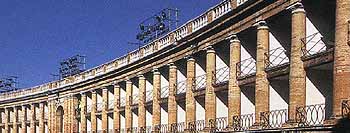
Sferisterio - Macerata
Its opera festival in July and August has found an international following and takes place in the 7,000-seater Sferisterio - a monster of a Neo-classical arena erected by private subscription in the 1820's. As you swoon to a Verdi aria, you might care to remember that it was originally built as a stadium for pallone, or Italian football. The town centre has a measured dignity fitting the place's solid, if unostentatious wealth. Its centre was almost entirely built between the 16th and 19thC. The Renaissance two-tiered arcades of the Loggia dei Mercanti on the central Piazza della Liberta' is the most striking pieces of architecture. The best of the city's palaces line Corso Matteotti, the road that leaves the square at the side of the Loggia, while Corso della Repubblica will take you to Piazza Vittorio Veneto and the civic gallery and museum. Here is a mixed bag of works by umbro-marchigiani painters - most important is Carlo Crivelli's Madonna and Child.
Part III - Macerata to Offagna
Head down from Macerata to the valley of the river Potenza, following the signs for Ancona. Crossing the river at Villa Potenza, we come across a large amphitheatre on the left of the main road. These are the remains of the ancient settlement of Helvia Ricina. When the Visigoths destroyed it in the 5th-6th century, its inhabitants ran away to higher ground and founded Macerata. Excavations have also uncovered an ancient embankment along the riverside and a stretch of ancient stone-paved roadway nearby.
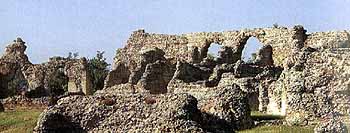
Helvia Recina - Villa Potenza
Continuing northwards, we leave the main road to make for Montecassiano. Its small piazza is particularly worth a visit. The solid 15th century Palazzo Comunale, built over a shady portico, has three beautiful bottle-glazed windows. Steps lead through an archway to one side, up to the parish church, topped by a stubby spire. Inside the sober Gothic brick interior, there is refreshingly unrestored terracotta altarpiece by Mattia Della Robbia (1527), a lesser-known member of the famous Florentine artistic family.
Driving on to the pretty town of Montefano, the attraction here is the Castello di Montefiore, just outside. Built in the 14th century, it was later so well adapted to artillery defence that it remained intact through the centuries and it was the only the bombs of the Second World War which succeeded in damaging it. Since then, however, it has been sensitively restored and has a dramatic gateway and ramp which take you up to the castle keep.
Driving back through Montefano, our route now takes us in the direction of Jesi, passing through Filottrano with its church of San Francesco - a fine example of late Baroque architecture - before turning eastwards through delightful open countryside, back in the direction of Ancona.
The final stop is at Offagna, dominated by the solid tower of its picturesque 15th century rocca, or castle. Just below, the Palazzo Municipale , adorned with noble coats of arms, adds to the attractions of this charming small town. Heading back on the home stretch of the journey, we are once again among the vineyards that produce Rosso Conero.